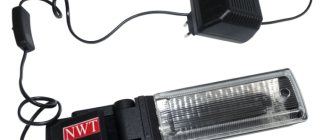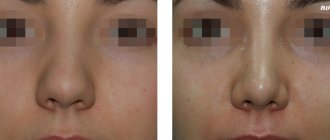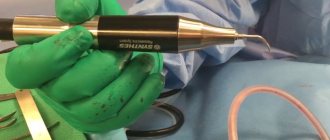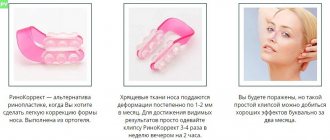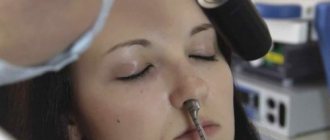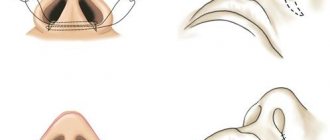Its drooping becomes a serious problem because it violates the accepted aesthetic proportions - the nasolabial angle acquires the wrong degree - less than 90°, and the symmetry of the face is also generally disturbed.
The drooping becomes more pronounced with age, when gravitational ptosis is already clearly visible - the skin of the back and tip loses its elasticity and firmness, the tip becomes thicker and droops more and more.
You can raise the tip of the nose either with or without surgery - with the help of fillers, threads, Botox, etc. Let's take a closer look at all the possible methods for correcting the defect.
Clamps and splints
On sale you can find nasal correctors from the brands NoseUp, Rhinocorrect, etc. These are clips that are attached to the nose. They need to be worn 2-3 hours a day so that, according to the manufacturers, a result comparable to plastic surgery appears.
In fact, correctors are completely ineffective. You cannot fix your nose by putting short-term pressure on it.
A splint is a device made of plaster or plastic. It is used to correct the contour of the nose. The splint puts pressure on the cartilage and corrects defects - it narrows the wings, raises the tip, smoothes out the hump (if it is completely cartilaginous). However, you don’t need to expect colossal changes - the correction will be very minor, and the effect will be short-lived if you stop using the corrector.
What types of corrections do I carry out?
You can contact me for any type of surgery to correct aesthetic defects of the nose:
- Complete rhinoseptoplasty;
- Classic rhinoplasty of the nose with a hump;
- Rhinoplasty of the tip of the nose;
- Septoplasty;
- Rhinoplasty of Asian nose.
You can also send me your photos for consultation. Send a photo and a message about the desired result to [email protected]
His work speaks best for a surgeon. I suggest you look through photos of the work and read patient reviews on this site and on well-known forums.
Exercises (face building)
The author of the most effective technique is Carol Maggio. She has developed a whole set of exercises for face-building, which can be found in her book. It all started with the fact that Carol herself was able to change the tip after an unsuccessful rhinoplasty.
By the way, these exercises are recommended for people without pronounced defects. They will help keep your nose young and beautiful longer.
Example exercise to raise the tip:
1) With the index finger and thumb of your right hand, grasp and pinch your nostrils tightly. Place the index finger of your left hand on the tip with the pad up and lift it. At this moment the upper lip rises.
2) While in the starting position, tense your upper lip and lower it, resisting the nasal muscles.
3) Repeat every day 40 times. The effect will be noticeable after 2-3 months, but the exercises must be continued constantly.
Basic principles of nasal tip plastic surgery
If a person naturally has a raised tip of the nose, this cosmetic defect is corrected in a plastic surgery clinic, the same applies to the drooping end of the organ. Surgical interventions on this part of the face are technically very complex and require a high level of qualification from the surgeon. The main principle of nasal tip rhinoplasty is to preserve the supporting cartilage structures, while the doctor works with the lower layers, changing their shape and position. It is very important that during the operation there is no skewing of the end of the nose or further drooping. The surgeon mainly performs exclusively corrective manipulations of the tip of the nose.
Based on the main goals and objectives of surgical intervention, the operation can be called corrective, which allows it to be classified as a gentle technique, since the doctor works only with cartilage. But it is worth remembering that the nose is the most visible part of our face, any medical error will be noticeable, therefore the surgeon must be very precise in determining the points of movement of the tip of the nose. If all the rules and techniques of the operation are followed, the patient will receive a new nose shape with a harmonious, symmetrical and proportionally correct tip.
Rhinoplasty, like other operations, has a number of contraindications, in the presence of which the intervention cannot be performed or is postponed until the contraindications are eliminated. Considering the fact that the growth and formation of the bones of the facial skeleton continues up to 20 years, the minimum age at which rhinoplasty can be performed is 18 years. If the operation is performed earlier, the process of bone formation several years later may worsen the result. Surgical intervention for patients under 18 years of age is performed only according to the indications of the attending physician and with parental consent. After 60 years, rhinoplasty is also performed with extreme caution, due to the poor ability of tissue to heal.
Contraindications for surgical intervention include:
- the presence of pathological diseases of internal organs;
- poor blood clotting;
- malignant and benign tumors;
- diabetes;
- heart diseases.
Before rhinoplasty, the doctor will definitely prescribe a full medical examination, during which it will be possible to determine the presence or absence of contraindications. In addition to the main contraindications, surgery is not performed in the following cases:
- the patient has allergic reactions to anesthetic drugs;
- inflammatory processes;
- period of pregnancy and lactation;
- weakened immunity.
Application of threads
The thread technique allows you to slightly raise the tip. The essence of the procedure is that the doctor inserts strong threads with notches into the tissue through micropunctures with a special needle. Thanks to the counter arrangement of notches on the threads, the skin and soft tissues are raised. Next, the threads are fixed in the desired position and become a frame that prevents the soft tissue from descending. To lift the tip, threads are passed through the cartilage and secured at the top of the nose.
Two days later, the cosmetologist trims the ends of the threads, after which the final result appears. It lasts for approximately three years.
Advantages of threads:
- minimum swelling and bruising;
- no significant complications;
- tissues are not affected in large quantities;
- speed of the procedure – about 20 minutes;
- no general anesthesia.
Injuries
There is no need to dwell on the mechanism of nasal injury - it is understandable. The mildest injuries are bruises and abrasions; they do not carry serious consequences and quickly pass without treatment. Antiseptics should be used to treat abrasions, as abrasions can become inflamed, which can cause infection of the skin and other tissues. For wounds of the external nose, they are treated with antiseptics and sutured.
Stitches are usually left in place for 7 days. For deep wounds with cartilage damage, the cartilage is first sutured, if possible through the perichondrium, and then the skin is sutured. Wound treatment is carried out in a gentle manner, and suturing is carried out in a cosmetic way, in order to maintain a good cosmetic effect in the future.
Fracture of the nasal bones
It occurs rarely in children, especially at an early age. This is due to the fact that the bony pyramid in children is small, and the cerebral part of the skull is more developed than the facial part, so the blow falls on the frontal area, which “protects” the olfactory organ from fracture. But fractures still happen.
Symptoms of a fracture requiring medical intervention:
- deformation of the nose (it may move to the side, the back or one of the slopes may become retracted);
- difficulty in nasal breathing (this can occur due to swelling of the mucous membrane or the formation of a septal hematoma);
- nosebleeds (if it is intense and prolonged, then it needs to stop);
- prolonged nasal discharge (very rare, but after trauma to the nose and facial bones, nasal liquorrhea occurs - the leakage of cerebrospinal fluid from the nasal cavity. This occurs due to a fracture of the bottom of the anterior cranial fossa and rupture of the dura mater).
Fractures often occur without displacement, which does not require additional treatment; it is enough to maintain mechanical rest of the damaged organ. Often, a patient consults a doctor when there is severe swelling of the soft tissues, and it becomes difficult to assess the degree of deformation. In such cases, it is recommended to wait until the swelling subsides, about 5-7 days. The deformity is assessed primarily clinically, even if a fracture is clearly identified on an X-ray or CT scan, and the nose is straight, without signs of deformation—reposition is not required.
Repositioning of the nasal bones
What is the time frame for repositioning? There is an early reposition, when swelling of the soft tissues has not had time to develop, this is the first 6-12 hours, and a late one, after the swelling has subsided, on days 5-7. The nasal bones can be realigned in up to three weeks. After reposition, their fixation is required; for this, tamponade is performed and a plaster or adhesive fixing bandage is applied.
The nasal tamponade is left for 3-5 days. Tampons cause noticeable discomfort, but they are still preferable because they support the nasal bones from the inside and also have hemostatic properties. After removing the tampons, you need to be observed by a doctor for some more time, since after tamponade the formation of synechiae (scar adhesions) in the nasal cavity is possible.
Reduction and tamponade are difficult to achieve in children. Due to fear and reluctance to participate in unpleasant procedures, for children, if necessary, the operation is performed under anesthesia.
Subluxation of the quadrangular cartilage
With nasal injuries, subluxation of the quadrangular septal cartilage often occurs. With this injury, as a rule, the lower parts of the cartilage are torn from the bottom of the nasal cavity. This injury is rarely diagnosed because it is not always clear whether the septum was previously deviated. Subluxation of the quadrangular cartilage can occur together with a fracture or independently.
Symptoms of this injury are nosebleeds, septal hematoma, changes in the position of the septum and collumella, and increased mobility of the quadrangular cartilage. The quadrangular cartilage is not reduced because it is difficult to fix. If the septum is deformed and nasal breathing is impaired, septoplasty is performed - surgical correction of the curvature of the nasal septum.
Almost all cases of deviated septum in adults are associated with trauma to the quadrilateral cartilage in childhood. Even minor trauma can result in rupture of the perichondrium or disruption of the connections of the quadrangular cartilage to surrounding structures.
Nosebleed due to injury
Occurs when the vessels of the nasal septum are damaged or when bones are broken with rupture of the skin and mucous membrane in the nasal cavity. Depending on the diameter of the vessel and the clotting ability of the blood, bleeding can be profuse, prolonged and lead to significant blood loss.
The main way to stop nosebleeds is with tamponade for several days. Sometimes, if the source of bleeding is clearly visible, electrocoagulation of the bleeding vessel is possible.
Hematoma of the nasal septum due to trauma
It occurs when blood vessels rupture in the thickness or under the mucous membrane of the septum, and blood, leaving the vascular bed, peeling off the mucous membrane, forms a cavity filled with blood. It may be on one side or both. Hematoma of the septum can accompany a fracture of the nasal bones, subluxation of the quadrangular cartilage, or occur independently.
The main symptom is difficulty in nasal breathing, which does not improve over time or by taking vasoconstrictor drops. Upon examination, a sharp thickening and cyanosis of the septum are determined; when pressing on the mucous membrane, its pliability is determined, with the adoption of the previous form - fluctuation.
Treatment of hematoma
In the first hours, a puncture of the cavity is performed and the blood is aspirated with a syringe, followed by anterior tamponade. After 9-12 hours or later, an incision is made along the front edge of the hematoma and the cavity is cleared of blood, since clots have already formed and it is not possible to aspirate them with a syringe. A graduate is placed into the incision and anterior tamponade is performed.
Subsequently, the nasal cavity is subjected to care several more times. A frequent complication is the development of suppuration of “old” blood with the formation of a septal abscess, so it is recommended to treat all hematomas.
Foreign bodies
Injuries to the olfactory organ can also include foreign bodies. This happens especially often in children, who, while playing, can stick various objects into their noses. Often parents do not know about this, but after some time they notice that the child cannot breathe in one nostril (much less often two) and a liquid with an unpleasant odor is released from it. The depth of the foreign body varies; it can be the vestibule of the nasal cavity or the cavity itself.
Sometimes foreign bodies can remain in the nasal cavity for years, gradually becoming overgrown with mineral layers of mucus, which forms rhinoliths, which can remain there for decades. If a foreign body is suspected, an examination by an ENT doctor is required with endoscopy, and sometimes a computed tomography scan of the paranasal sinuses.
Rhinoplasty of drooping nasal tip
Surgery is the most effective and reliable method of correction, providing significant lifelong results.
A “potato” nose and a drooping tip can form for two reasons:
- the skin on the nose is too thick - in this case it can be removed;
- too wide or convex lower and lateral cartilages.
With the help of surgery, you can reduce a rounded tip, raise a drooping one, straighten a curved one, or narrow a too wide one.
The drooping tip is corrected by removing part of the cartilage. Access can be open or closed. The first option involves an external incision and full visual control over the progress of the operation. First, an incision is made in the area of the nasal bridge, then the cartilage of the wings is released. Excess cartilage tissue is removed and sutures are applied. To raise the tip or strengthen it, post cartilage is used. The closed method involves an incision in the mucosa. Through it, the pterygoid cartilages are released, and sutures are applied to model the desired shape. The scope for the doctor’s actions in this case is not as wide as with open access, but the patient will not have an external scar.
The operation lasts 1-2 hours and can be performed under general anesthesia or local anesthesia.
Reduction of the tip of the nose without surgery using injections
If cosmetics and exercises do not bring the desired effect to the owner of a non-standard nose shape, it is worth using a method of non-surgical reduction of the tip of the nose, such as injection rhinoplasty. During this procedure, special drugs will be injected into the nose area to change its shape. Please note that injections will not make your nose smaller, but will help eliminate all dips, irregularities, and remove asymmetry. Injections with hormonal drugs can make your nose thinner and help remove excess tissue. Local anesthesia is mainly used for pain relief. The operation itself takes place quite quickly and has no negative consequences. The recovery period is short. The main disadvantage of this procedure is its short-term effect. Typically, patients seek a second procedure approximately a year after the first.
